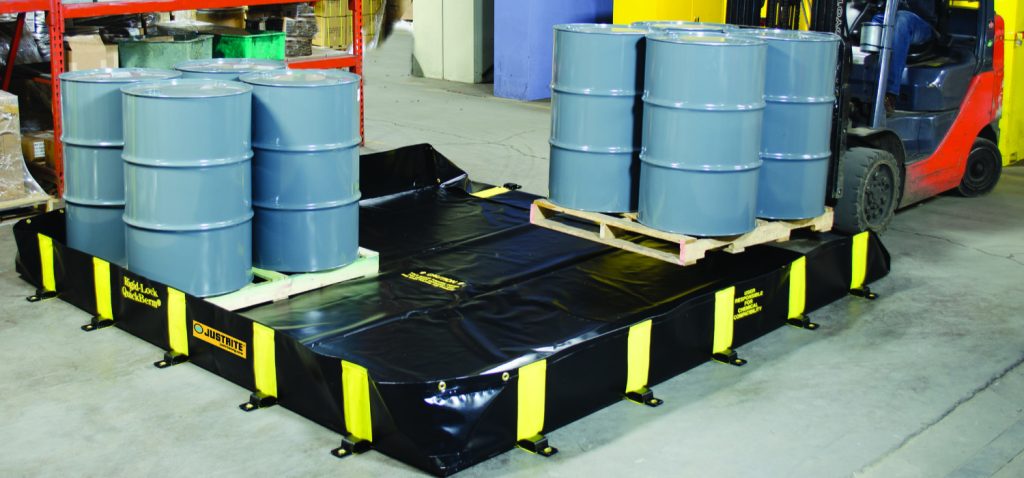We use cookies to make your experience better. To comply with the new e-Privacy directive, we need to ask for your consent to set the cookies. Learn more.
Secondary Containment, keeping you safe

When using, storing or transporting liquids on site, care must be taken to ensure you reduce the risks of spills. Legislation including the Oil Storage Regulations stipulate that steps must be in place to ensure people and the environment are protected from liquids. Having suitable secondary containment on site is vital in keeping you and the environment safe
What is secondary containment?
Secondary containment is designed to store your equipment, providing an extra catchment area for leaks. This may include drip trays, spill pallets for drums and IBCs, temporary bunds, oil and fuel tanks, bunded stores as well as specially built designated bunded areas on some larger sites. All of these solutions act as a second opportunity to catch liquids, hence the term secondary containment. As well as having effective secondary containment in place, you must also regularly inspect them to check their integrity. Maintenance and repairs must be carried out efficiently to keep you protected.Secondary containment can range from a drip tray to large bunded areas for storage of multiple containers. You will need to ensure different liquids are stored in separate bunds, to prevent them potentially mixing. Regulations for liquid storage differs depending on the number of containers you are storing:
Single Container Requirements
The secondary containment must have capacity to hold 110% of the capacity of the container. For example if your container has a capacity of 2,500 litres, your secondary containment must have capacity for 2,750 litres.Multiple Container Requirements
The secondary containment must provide either, capacity for one quarter or the combined liquid stored OR 110% of the capacity of the largest container, whichever is the larger quantity.You may have containers on site including drums, IBCs, cans or tanks to store your liquids. Accidents can happen, sometimes outside of your control, but these vessels can fail. If a failure occurs, without effective secondary containment in place, the incident escalates to a spill emergency. Any spill incident can range in potential risk to people and the environment, depending upon the hazardous liquid leaking out, as well as location and surroundings.
Have you carried out a site assessment?
A site assessment gives businesses the opportunity to look at their site through fresh eyes, looking for areas where issues may occur, and reducing the health and safety risks. If you need help with your site assessment, we offer a free of charge spill site assessment and recommendations to help highlight areas of concern.Site assessments include a range of questions about the liquids you use and steps you should consider. Highlighting the requirement for spill kits, spill stations and secondary containment as well as understanding your drainage system on site and where the drains lead too. Spills and leaks can quickly travel into drains if not contained correctly which could cause irreversible damage and pollution to the environment.
How do I know what secondary containment I need?
A site assessment would highlight the recommended secondary containment required. This may include spill pallets for drums or IBCs, temporary bunds or bunded trollies. Recommendations may also include external bunded stores for safe storage of containers, or drip trays for day to day use.If you have drains on site you should ensure you have steps in place to prevent spills from accessing waterways. If you have drains and grids, drain covers are a quick and effective solution to preventing spills from spreading. Alternatively, depending upon your site drain system, you should initiate your automated drain control valves. This would prevent hazardous liquids escaping into waterways through the site surface water drainage or foul sewer system.
Once a spill enters a waterway, the impact is colossal, to a business and the environment, which will involve an investigation by the HSE.
Equally care needs to be taken to ensure spills do not leak into a verge or soil, as this will also cause pollution to the environment. Having secondary containment will provide that emergency containment.
Choosing the correct secondary containment is important but can be dauting. Working with an experienced spill provider will ensure your business has the appropriate spill control to suit your business
Useful reading: HSE – Pollution Prevention for Businesses
Find out how we can help you visit: spillcraft.co.uk
Spill site survey | Managed Spill Service | Spill products | Spill training
You May Also be Interested In:
-

Site Survey
We assess your site, equipment, and spill training procedures, highlighting any potential danger zones that are apparent on site.
Read More -

Spill Training
Spill training courses designed to ensure your team are fully compliant and confident to prevent and deal with any spill incident.
Read More -

Managed Spill Service
A complete solution that we manage on your behalf, providing appropriate spill products with a regular audit and replenishment service
Read More -

Spill Equipment
Wide range of equipment to help prevent or respond to spills safely. Including safe storage, trollies, spill kits, PPE and much more
Read More

